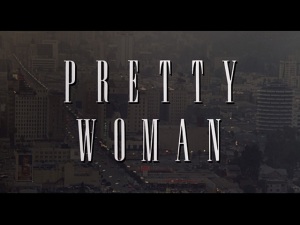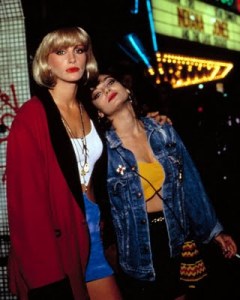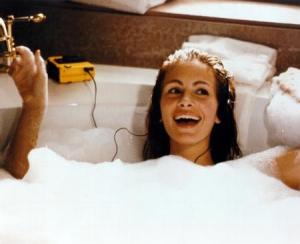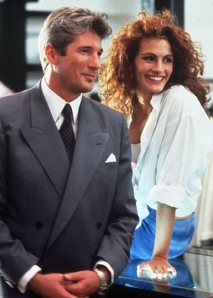Pretty Woman
Production Credits:
Director: Garry Marshall | Producer: Arnon Milchan, Steven Reuther, Gary W. Goldstein | Screenplay: J.F. Lawton | Cinematography: Charles Minsky | Country of Origin: USA | Year: 1990| Running Time: 119 min
Principal Cast: Richard Gere, Julia Roberts, Hector Elizondo, Jason Alexander, Laura San Giacomo
In 1990, Disney released a modern-day version of the Cinderella story. Or more accurately a Cinderella story with a twist for in Pretty Woman, Prince Charming is a businessman and Cinderella is a street walker. Originally intended to be a serious drama, the film was later re-conceived as romantic comedy with a large budget. Widely successful at the box office, it became one of the highest moneymakers of 1990 establishing Julia Roberts as a star overnight.
Pretty Woman was initially conceived to be a dark story about prostitution in New York City in the late 1980s. The relationship between Vivian and Edward also originally harboured controversial themes, including the concept of having Vivian addicted to drugs; part of the deal was that she had to stay off cocaine for a week, because she needed the money to go to Disneyland. Edward eventually throws her out of his car and drives off. The movie was scripted to end with Vivian and her prostitute friend on the bus to Disneyland. Roberts would later describe the original script as
“a really dark and depressing, horrible, terrible story about two horrible people and my character was this drug addict, a bad-tempered, foulmouthed, ill-humored, poorly educated hooker who had this weeklong experience with a foulmouthed, ill-tempered, bad-humored, very wealthy, handsome but horrible man and it was just a grisly, ugly story about these two people.”
The original script was bought by Vestron Pictures to be shot as a low-budget film. When Vestron went out of business, producers Steve Reuther and Arnon Milchan got involved and managed to gain the interest both Universal and Touchstone Films (a division of Disney). After a bidding war, the rights to 3000 were eventually sold to Touchstone for $17 million. When Touchtone took over production, the film found a new director in Garry Marshall, who was admittedly nervous about taking on the
project. Executives at Disney wanted to lighten-up the subject matter and screenwriter Lawton was asked to do another draft of the script. As he later remembered “I did two drafts that made it more of a love story – they got together at the end. I took out the fact that he had a girlfriend he was cheating on with her and a few other things, and Disney’s reaction was that I’d gone too far, lightened it up too much.” In all the script would go through six drafts by several writers. One example of the changed plotline occurs when a suspicious Edward breaks into the bathroom to find Vivian flossing her teeth instead of doing drugs as he had feared. In the original script she was doing drugs.
Casting of Pretty Woman was a rather lengthy process. For the lead role of Vivian, director Garry Marshall originally envisioned Karen Allen or Mary Steenburgen. Meg Ryan was also a top choice of Marshall’s, but all turned him down. The part then went to many better-known actresses of the time including Michelle Pfeiffer, Darryl Hannah and Molly Ringwald, who turned it down because she felt uncomfortable with the content in the script, and did not like the idea of playing a prostitute. Ringwald has since stated in several interviews that she regrets the decision. Winona
Ryder, who was a popular box-office draw at the time, was considered, and auditioned, but turned down because Marshall felt she was “too young”; as was Jennifer Connelly. When all the other actresses turned down the role, 21-year-old Julia Roberts, a relative unknown at the time, with the exception of her Oscar nominated performance in the film Steel Magnolias, won the part. Her performance would make her a star.
For the male lead, Marshall had initially considered Christopher Reeve and John Travolta. Al Pacino was also in the running, going as far as doing a casting reading with Roberts before turning the leading role down. Richard Gere was suggested early on, but Gere who had read 3000 and rejected it. It took a trip from Roberts and Marshall to Gere’s apartment in New York to persuade him before he finally agreed to
the project.
Principal photography commenced on July 24, 1989 and was completed on October 18, 1989. Filming locations included the Regent Beverly Wilshire hotel on Rodeo Drive (which was the only hotel that would allow its exterior and lobby to be filmed), the former Ambassador Hotel, and various sites in San Francisco, including the War Memorial Opera House. Sets were built in Burbank to double as the hotel rooms and Edward’s office. Filming was generally pleasurable and easy-going experience for those involved, the films budget was broad and the shooting schedule was flexible. Filmmakers did face issues when it came to the car that Lewis drove as both Ferrari and Porsche had declined the product placement opportunity of the car Edward drove, because the manufacturers did not want to be associated with soliciting prostitutes. Fortunately Lotus Cars saw the placement value with such a major feature film and supplied a Silver 1989.5 Esprit SE, a smart move by the company as the sales of the Lotus Esprit tripled during 1990-91.
There are several interesting stories from the production of the film such as the well-known story of the scene in which Gere playfully snaps the lid of a jewelry case on Roberts’ fingers which was improvised by Gere, and Roberts’ surprised laugh was genuine. The necklace really cost $250,000 which resulted in a security man from the jewelry store equipped with a gun was constantly standing behind the director.
To produce the hysterical laughter during the scene where Vivian is lying down on the floor of Edward’s penthouse, watching re-runs of I Love Lucy, Marshall tickled Roberts’s feet (out of camera range) producing the genuine laughter shown in the film. During the famous scene in which Roberts sings along to Prince in the bathtub sliding down and dunking her head under the bubbles, Roberts came up and opened her eyes and saw that everyone had left the set, even the cameraman, who got the shot.
Roberts also had some difficulties during the love-making scene with Gere, getting so nervous that a vein visibly popped out on her forehead. She also developed a case of hives, and calamine lotion was given to clear them until shooting could resume. According to the DVD director’s commentary during the lovemaking scene on the piano, the piano key sounds that are made had to be dubbed in because the actual keys that were randomly hit by Julia and Richard as they did the scene. This resulted in such a discordant sound that it could not be used in the actual movie.
In its opening weekend, Pretty Woman opened at number one at the box office grossing $11,280,591 and remained number one at the box office for four non-consecutive weeks and in the top ten for sixteen weeks. It would go on to be the fourth highest-grossing film of 1990 in the United States and the third highest-grossing worldwide. Today it is still one of the most financially successful entries in the romantic comedy genre, with an estimated gross income of $463.4 million. The
film received mixed to positive reviews from critics, who particularly focused on the performance of Roberts. It received four Golden Globe Awards nominations: Best Motion Picture, Best Actor for Richard Gere, Best Supporting Actor for Hector Elizondo and won the Best Actress for Julia Roberts. Roberts would also earn her second Academy Award nomination and her first nomination for Best Actress for her work in the film.
Some Interesting Trivia:
Director Garry Marshall shares a fear of heights with Richard Gere’s character, Edward Lewis.
The original script was titled $3,000, but it was changed because executives at Touchstone thought it sounded like a title for a Science Fiction film.
Many of the unsavory traits given to the character of Vivian in the original script were removed or incorporated into the character of Vivian’s friend, Kit.
Some of the scenes filmed for the original darker version of the film were included on the DVD released on the film’s 15th anniversary such as a scene where Vivian is confronted by drug dealers outside The Blue Banana, and is rescued by Edward and Darryl.
For the film’s poster Julia Roberts’s head was superimposed on Shelley Michelle’s body and Richard Gere’s hair is brown on the poster but graying in the movie.
Julia Roberts earned $300,000 for her role.
Roberts prepared for her role by talking to prostitutes on Hollywood Boulevard.
The opera Richard Gere takes Julia Roberts to is La Traviata, which is about a prostitute who falls in love with a wealthy man.
Richard Gere is actually playing the piano. He also composed the piece of music that is played.
When Jason Alexander slams the door to his car they actually had to replace it, because the window broke.
The red coat that Vivian wears was bought for $30 from a movie usher in the street shortly before filming.
In the shots of the city in the very beginning, you will notice that some of the neon letters in the hotel where Vivian lives are burned out. The only remaining lighted letters spell “HO”.
Further Reading:
Pretty Woman: 15th anniversary. Buena Vista Home Entertainment, Touchstone. 2005.
Owen Gleiberman (1990-03-23). Pretty Woman. Entertainment Weekly.







